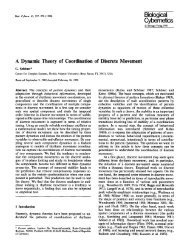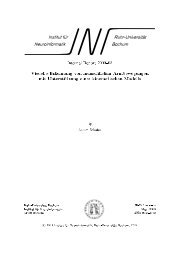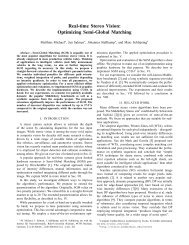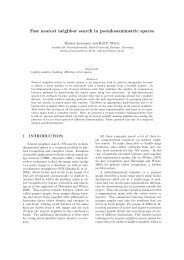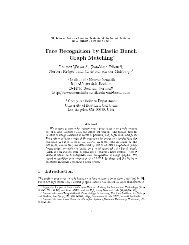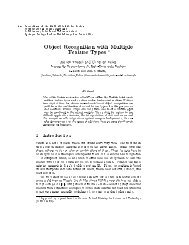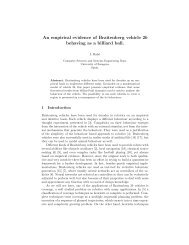How Are Neural Signals Related to Each Other and to the World?
How Are Neural Signals Related to Each Other and to the World?
How Are Neural Signals Related to Each Other and to the World?
Create successful ePaper yourself
Turn your PDF publications into a flip-book with our unique Google optimized e-Paper software.
Chris<strong>to</strong>ph von der Malsburg<br />
<strong>How</strong> <strong>Are</strong> <strong>Neural</strong> <strong>Signals</strong> <strong>Related</strong><br />
<strong>to</strong> <strong>Each</strong> <strong>O<strong>the</strong>r</strong> <strong>and</strong> <strong>to</strong> <strong>the</strong> <strong>World</strong><br />
Abstract: The core of this paper is a discussion of how <strong>the</strong> physical signals of <strong>the</strong><br />
nervous system acquire significance <strong>and</strong> meaning on <strong>the</strong> basis of relationships<br />
with each o<strong>the</strong>r <strong>and</strong> with <strong>the</strong> environment. Signal relations are discussed in terms<br />
of coherence (defined as lack of resistance), prediction, intentionality, inner reality<br />
<strong>and</strong> meaning. The original <strong>and</strong> most basic type of signal relation has <strong>the</strong> form of<br />
temporal correlations on coarser or finer time scales, <strong>and</strong> all o<strong>the</strong>r relations must<br />
ultimately be built up by <strong>the</strong> brain from this basis. Consequently, consciousness is<br />
<strong>the</strong> state of coherence of <strong>the</strong> brain in terms of signal relationships within it <strong>and</strong><br />
with <strong>the</strong> environment. In this view, consciousness is of critical functional importance<br />
<strong>and</strong> far from a superfluous epiphenomenon. Underst<strong>and</strong>ing <strong>the</strong> mechanisms<br />
by which meaningful signal relationships are established in <strong>the</strong> brain is of great<br />
importance for <strong>the</strong> future of information technology.<br />
Trying <strong>to</strong> underst<strong>and</strong> <strong>the</strong> nervous system <strong>to</strong> <strong>the</strong> point of being able <strong>to</strong> reproduce<br />
its function in artifacts is a venture of great scientific importance. The study of<br />
consciousness may be far removed from this venture, yet I think it is time this<br />
link is made. In my professional specialty of computer modelling of vision, for<br />
instance, it has become clear in recent years that individual functional components<br />
(such as for <strong>the</strong> detection of edges or motion or stereo depth from visual<br />
input in natural environments) cannot be made <strong>to</strong> function reliably <strong>and</strong> that only<br />
integrated systems of many such interlinked sub-systems will be able <strong>to</strong> interpret<br />
visual scenes in a meaningful <strong>and</strong> reliable way (for two examples see Steinhage,<br />
2000, <strong>and</strong> Triesch <strong>and</strong> von der Malsburg, 2001). I argue here that <strong>the</strong> issues of<br />
consciousness, symbol meaning <strong>and</strong> intentionality are all intimately linked with<br />
<strong>the</strong> problem of sub-system integration in <strong>the</strong> brain. It may be expected that <strong>the</strong><br />
link that I am pointing <strong>to</strong> here can, if taken seriously, lead <strong>to</strong> important mutual<br />
benefits for all fields involved.<br />
Correspondence:<br />
Chris<strong>to</strong>ph von der Malsburg, Institut für Neuroinformatik, Ruhr-Universität Bochum,<br />
D-44780 Bochum, Germany.<br />
Journal of Consciousness Studies, 9, No. 1, 2002, pp. 47–60
48 C. VON DER MALSBURG<br />
Resistance, Coherence <strong>and</strong> Prediction<br />
Our organism is exchanging a constant flood of signals <strong>and</strong> interactions with <strong>the</strong><br />
surrounding world via arrays of afferent <strong>and</strong> efferent signal pathways. Patterns of<br />
signals <strong>and</strong> <strong>the</strong>ir statistical structure is all that we can know about <strong>the</strong> world, a<br />
thought captured so well in Pla<strong>to</strong>’s cave metaphor. To decipher this code, our<br />
brain relies heavily on active experiments, manipulating <strong>the</strong> environment <strong>and</strong><br />
controlling our location <strong>and</strong> orientation, <strong>the</strong>reby selecting <strong>and</strong> influencing sensory<br />
input in reliable <strong>and</strong> reproducible ways. It has long been recognized that this<br />
action–perception cycle is an important aspect of <strong>the</strong> way in which our interaction<br />
with <strong>the</strong> world enables us <strong>to</strong> learn <strong>and</strong> perceive (in <strong>the</strong> context of vision it<br />
was especially J.J. Gibson, 1950, who emphasized <strong>the</strong> importance of <strong>the</strong> subject’s<br />
active involvement; see also Held <strong>and</strong> Hein, 1963, <strong>and</strong> <strong>the</strong> more recent<br />
movement of ‘active vision’, Blake & Yuille, 1992). This interaction with <strong>the</strong><br />
world varies according <strong>to</strong> <strong>the</strong> resistance that we encounter. 1 In <strong>the</strong> literal sense,<br />
resistance is opposition of <strong>the</strong> world <strong>to</strong> an attempted movement of our limbs or a<br />
<strong>to</strong>ol, leading <strong>to</strong> failure <strong>to</strong> complete an intended movement. In a generalized<br />
sense, resistance occurs as failure <strong>to</strong> complete an intended action, as discrepancy<br />
between sensory signals <strong>and</strong> internal predictions, <strong>and</strong> in <strong>the</strong> worst form, resistance<br />
takes <strong>the</strong> form of pain <strong>and</strong> damage inflicted upon us.<br />
It is one important purpose of <strong>the</strong> brain <strong>to</strong> avoid or reduce <strong>the</strong> resistance it<br />
experiences. Important for this purpose is <strong>the</strong> ability <strong>to</strong> predict events, or potential<br />
events contingent upon <strong>the</strong> moves at our disposal. It is amazing <strong>to</strong> what<br />
degree <strong>and</strong> detail our brain is precise in its expectations. We are reminded of this<br />
when <strong>the</strong>re is unexpected discrepancy (such as when our h<strong>and</strong> shoots up when<br />
trying <strong>to</strong> lift an object that is much lighter than expected). Partly, <strong>the</strong>se expectations<br />
are created on <strong>the</strong> basis of fixed laws. Thus, when turning our eyes we<br />
expect <strong>the</strong> images on our retinae <strong>to</strong> move accordingly. A precise prediction of<br />
image motion must be based on <strong>the</strong> ‘law’ governing <strong>the</strong> relation between image<br />
<strong>and</strong> eye rotation, <strong>and</strong> knowledge of <strong>the</strong> actual motion state, presumably made<br />
available in <strong>the</strong> form of an efference copy of <strong>the</strong> mo<strong>to</strong>r comm<strong>and</strong> responsible for<br />
<strong>the</strong> eye movement. As soon as a prediction turns out imprecise (as when <strong>the</strong> eye<br />
is passively moved by a finger pressing against <strong>the</strong> eyelid, causing a discrepancy<br />
between <strong>the</strong> efference copy <strong>and</strong> <strong>the</strong> actual eye position) we are alerted <strong>and</strong> sense<br />
what I am calling resistance. 2 Generally speaking, signal prediction always<br />
necessitates internal models of fixed laws <strong>and</strong> regularities <strong>and</strong> <strong>the</strong> representation<br />
of <strong>the</strong> actual situation surrounding us. 3<br />
[1] I am borrowing <strong>the</strong> term resistance from <strong>the</strong>ory of science (Pickering, 1995).<br />
[2] In <strong>the</strong> example, <strong>the</strong> discrepancy between actual <strong>and</strong> expected retinal image motion is interpreted as<br />
movement of <strong>the</strong> environment.<br />
[3] In reality, those two form a continuum, laws <strong>and</strong> regularities just relying on more slowly varying or<br />
constant aspects of <strong>the</strong> environment. In <strong>the</strong> eye-movement example, <strong>the</strong> law governing <strong>the</strong> relationship<br />
between efferent copy <strong>and</strong> image movement is defined by <strong>the</strong> oculo-mo<strong>to</strong>r system, <strong>the</strong> properties<br />
of which might change over time — in which case <strong>the</strong> brain would have <strong>to</strong> take note of this as just<br />
ano<strong>the</strong>r change in <strong>the</strong> situation.
HOW ARE NEURAL SIGNALS RELATED 49<br />
Coherence is <strong>the</strong> opposite of resistance. A coherent system is one that is structured<br />
so as <strong>to</strong> produce very little resistance, <strong>to</strong> be right with its predictions <strong>to</strong> a<br />
large extent. Coherence with <strong>the</strong> environment means success in terms of correct<br />
prediction of actual or possible events such that <strong>the</strong> organism can pursue its<br />
opportunities <strong>and</strong> avoid damage in making proper choice from among <strong>the</strong> contingencies.<br />
Inside <strong>the</strong> nervous system, coherence means agreement between signals<br />
where <strong>the</strong>y converge.<br />
Seeing our organism <strong>and</strong> <strong>the</strong> environment as a network of interacting signals,<br />
one may classify elementary events ei<strong>the</strong>r as causes or as effects. Causes are<br />
‘spontaneous’ events that <strong>the</strong>mselves are not caused by o<strong>the</strong>r events in <strong>the</strong> network<br />
but are due <strong>to</strong> some extraneous influence or are created spontaneously in<br />
some more proper sense of that word. Effects are regular consequences downstream<br />
from causes, produced by <strong>the</strong> regular transmissions <strong>and</strong> interactions<br />
within <strong>the</strong> network. 4<br />
Causes, being spontaneous, cannot be predicted or anticipated. <strong>How</strong>ever, <strong>the</strong><br />
various effects of <strong>the</strong> same cause, being produced by <strong>the</strong> regular signal pathways<br />
in <strong>the</strong> system, st<strong>and</strong> in regular relationships <strong>to</strong> each o<strong>the</strong>r, <strong>and</strong> some of <strong>the</strong>m can<br />
be used <strong>to</strong> predict o<strong>the</strong>rs. Thus, <strong>the</strong> ultimate basis for all predictions <strong>and</strong> for all<br />
coherence in a system is <strong>the</strong> existence of alternate signal pathways <strong>and</strong> causal<br />
chains that start from an original event <strong>and</strong> converge, possibly after several transformations,<br />
on a common destination, where one of <strong>the</strong>m may serve <strong>to</strong> predict<br />
o<strong>the</strong>rs. In <strong>the</strong> eye movement example, <strong>the</strong> relevant cause is <strong>the</strong> spontaneous comm<strong>and</strong><br />
<strong>to</strong> shift gaze (or <strong>the</strong> peripheral visual event that triggered it). One signal<br />
pathway is <strong>the</strong> oculo-mo<strong>to</strong>r pathway that executes <strong>the</strong> comm<strong>and</strong>, creating movement<br />
of <strong>the</strong> retinal image which is <strong>the</strong>n transmitted <strong>to</strong> <strong>the</strong> visual system. A second<br />
pathway transmits <strong>the</strong> efference copy <strong>to</strong> <strong>the</strong> visual system where it is used <strong>to</strong> predict<br />
<strong>the</strong> image shift (or <strong>the</strong> arrival of <strong>the</strong> original visual stimulus in <strong>the</strong> fovea). An<br />
extensively studied experimental paradigm is <strong>the</strong> vestibulo-ocular reflex (<strong>the</strong><br />
compensation of head rotation by eye movement <strong>to</strong> stabilize <strong>the</strong> retinal image,<br />
Anastasio, 1995) where resistance, in <strong>the</strong> form of residual image movement, can<br />
be induced by lesion of one of <strong>the</strong> pathways involved (Burt & Flohr, 1991), a<br />
discrepancy which is subsequently reduced by plasticity mechanisms (Burt &<br />
Flohr, 1991), as modelled by Anastasio (1995).<br />
Our brain is a vast array <strong>and</strong> network of events, signals <strong>and</strong> signal interactions.<br />
Whole arrays of signals are constantly compared <strong>and</strong> checked against each o<strong>the</strong>r<br />
<strong>to</strong> produce coherence. There is a temporal <strong>and</strong> a spatial aspect of <strong>the</strong>se signal<br />
arrays. Under <strong>the</strong> temporal aspect, <strong>the</strong> decisive issue is whe<strong>the</strong>r two signals are<br />
temporally correlated beyond what can be expected on <strong>the</strong> basis of individual<br />
signal statistics, one of <strong>the</strong> signals predicting <strong>the</strong> o<strong>the</strong>r. Under <strong>the</strong> spatial aspect,<br />
arrays of simultaneously arriving signals may or may not fit <strong>the</strong> patterns of signals<br />
<strong>the</strong>y impinge upon. Spatio-temporal arrays of signals can be considered as<br />
complex symbols which express <strong>the</strong> underlying events <strong>and</strong> causes. Different<br />
[4] The classification cause–effect depends, of course, on <strong>the</strong> system under consideration. When focusing<br />
on a small part of our brain, many of <strong>the</strong> signals impinging on it would have <strong>to</strong> be interpreted as<br />
causes, whereas under more global purview <strong>the</strong>y could be recognized as effects <strong>the</strong>mselves.
50 C. VON DER MALSBURG<br />
subsystems of our brain (or indeed of our whole organism <strong>and</strong> <strong>the</strong> environment if<br />
one adopts a more comprehensive view) have different symbol structures, <strong>the</strong><br />
same event getting expressed in very different codes. In order <strong>to</strong> be able <strong>to</strong> bring<br />
symbols in contact <strong>and</strong> check <strong>the</strong>m against each o<strong>the</strong>r <strong>the</strong> signal pathways between<br />
subsystems must translate between <strong>the</strong> different codes, this translation being performed<br />
by networks serving as transducers <strong>and</strong> interfaces between subsystems.<br />
Much of <strong>the</strong> description of coherence that I have just given can also be applied<br />
<strong>to</strong> <strong>the</strong> web of signals <strong>and</strong> interactions that are exchanged within a rock when hit<br />
by ano<strong>the</strong>r rock. The ensuing internal vibrations are transmitted over diverging<br />
<strong>and</strong> converging pathways, molecular motions at one place being <strong>the</strong> result of<br />
converging signals <strong>and</strong> local properties, <strong>and</strong> <strong>the</strong> whole array of motions can certainly<br />
be called coherent. 5 A very fundamental difference <strong>to</strong> <strong>the</strong> brain, though,<br />
resides in <strong>the</strong> fact that any motion within <strong>the</strong> rock is a passive reaction <strong>to</strong> arriving<br />
signals, <strong>and</strong> that <strong>the</strong>re is nothing that could be interpreted as a prediction.<br />
Although one may be speaking only of a tiny shift in signal timing when turning a<br />
reaction in<strong>to</strong> a prediction, it amounts <strong>to</strong> a tremendous functional difference (as<br />
any s<strong>to</strong>ck-market trader knows), <strong>and</strong> <strong>the</strong> transition is very non-trivial <strong>to</strong> achieve.<br />
Ano<strong>the</strong>r way in which an animal differs from a rock is, of course, its physical activity,<br />
making signal coherence so much more interesting <strong>and</strong> difficult <strong>to</strong> achieve.<br />
Establishment of Coherence<br />
Identifying <strong>the</strong> mechanisms for <strong>the</strong> establishment of coherence in our brain is a<br />
very complex problem <strong>and</strong> will remain a research subject for some time <strong>to</strong> come.<br />
Embedded in it are many long-st<strong>and</strong>ing problems, including that of learning <strong>and</strong><br />
epistemology. The mechanisms that create coherence in my brain at this moment<br />
in time reach back over several time scales, spanning logogeny, learning, on<strong>to</strong>geny<br />
<strong>and</strong> phylogeny. In <strong>the</strong> process, <strong>the</strong> organism has <strong>to</strong> adapt <strong>to</strong> <strong>the</strong> environment<br />
<strong>and</strong> its regularities, <strong>and</strong> <strong>the</strong> different parts of <strong>the</strong> organism <strong>and</strong> <strong>the</strong> brain have <strong>to</strong><br />
adapt <strong>to</strong> each o<strong>the</strong>r. It is not an option <strong>to</strong> imagine this adaptation <strong>to</strong> be akin <strong>to</strong> a<br />
copying mechanism that transfers <strong>the</strong> structure of <strong>the</strong> environment in<strong>to</strong> <strong>the</strong> brain<br />
or of <strong>the</strong> structure of one part of <strong>the</strong> brain <strong>to</strong> ano<strong>the</strong>r. The different subsystems<br />
speak very different languages <strong>and</strong> only at <strong>the</strong> interfaces between <strong>the</strong>m can <strong>the</strong>y<br />
be compared at all, in terms of local resonance in time <strong>and</strong> over different<br />
sub-channels. We will have <strong>to</strong> have recourse <strong>to</strong> general mechanisms of selforganization<br />
<strong>to</strong> underst<strong>and</strong> how organisms steadily increase <strong>the</strong> level of coherence<br />
<strong>the</strong>y achieve. Brain modelling <strong>and</strong> information technology are only just<br />
now beginning <strong>to</strong> realize <strong>the</strong> importance of underst<strong>and</strong>ing <strong>the</strong> general principles<br />
<strong>and</strong> mechanisms for <strong>the</strong> integration of different subsystems, for early examples<br />
see (Steinhage, 2000; Triesch <strong>and</strong> von der Malsburg, 2001).<br />
Logogeny is <strong>the</strong> process by which <strong>the</strong> current state of our brain is organized.<br />
We experience it as <strong>the</strong> process of concentrating on an issue, of directing our<br />
attention at something, of getting in<strong>to</strong> a definite context, of tuning in with <strong>the</strong><br />
[5] It is a surprisingly creative exercise <strong>to</strong> test ideas about consciousness on rocks, as was brought home <strong>to</strong><br />
me by my colleague Arm<strong>and</strong> R. Tanguay, Jr. in a series of inspiring discussions.
HOW ARE NEURAL SIGNALS RELATED 51<br />
subject matter of current interest. As <strong>the</strong>se terms already imply, logogeny is a<br />
process of selection <strong>and</strong> specialization <strong>to</strong> a narrow context. The environment we<br />
are immersed in at a given moment always has embedded in it a large number of<br />
<strong>the</strong>mes, processes <strong>and</strong> aspects that evolve side by side <strong>and</strong> without predictable<br />
relationships between <strong>the</strong>m. It is possible <strong>to</strong> establish definite signal relations<br />
<strong>and</strong> coherence only at <strong>the</strong> price of narrowing attention down <strong>to</strong> narrow functional<br />
components of <strong>the</strong> situation. We do that by directing our gaze at a definite object,<br />
by shutting out all sounds but one, by concentrating on one task at a time. This<br />
selection process takes place on a hierarchy of time scales <strong>and</strong> accompanying<br />
scales of contextual breadth. On a slower time scale we may set ourselves a more<br />
comprehensive task, which we may pursue over minutes or longer. Correspondingly<br />
<strong>the</strong> appropriate context is of a wider scale, <strong>and</strong> we collect <strong>and</strong> activate all<br />
<strong>the</strong> facts that are relevant <strong>to</strong> that wider context. On <strong>the</strong> short end of <strong>the</strong> hierarchy<br />
we direct our attention in a rapid sequence at very narrow patterns, particular<br />
objects or even parts of objects, coordinating all that while <strong>the</strong> different subsystems<br />
of our brain <strong>and</strong> body with each o<strong>the</strong>r, so as <strong>to</strong> be able <strong>to</strong> establish repeatable<br />
relationships in terms of exchanged signals. The definition of coherence ultimately<br />
has <strong>to</strong> rely in a circular way on <strong>the</strong> ability of different subsystems <strong>to</strong> establish signal<br />
relationships reliably in <strong>the</strong> presence of changing contexts. Progress with <strong>the</strong><br />
nature of coherence will only be possible on <strong>the</strong> basis of better knowledge of <strong>the</strong><br />
mechanisms of self-organization by which it is established in <strong>the</strong> brain.<br />
A typical context may be my sitting down at <strong>the</strong> breakfast table in <strong>the</strong> morning.<br />
My brain activates immediately all my expectations <strong>and</strong> habits connected<br />
with that activity. A more narrow context is my pouring tea. For a brief<br />
moment, my eyes look for <strong>the</strong> teapot, my visual system recognizes it <strong>and</strong> its<br />
parts <strong>and</strong> sends out signals <strong>to</strong> o<strong>the</strong>r regions of <strong>the</strong> brain specifying <strong>the</strong> whereabouts<br />
of <strong>the</strong> h<strong>and</strong>le, complete with information on shape, position <strong>and</strong> pose, so<br />
that <strong>the</strong> mo<strong>to</strong>r part of my brain can fall in<strong>to</strong> a pattern that controls my arm <strong>and</strong><br />
h<strong>and</strong> <strong>to</strong> grasp it. At <strong>the</strong> same time, some parts of my brain have more information<br />
on <strong>the</strong> teapot, sending signals that it is probably full <strong>and</strong> correspondingly<br />
heavy, <strong>and</strong> that it is hot (of which latter fact <strong>the</strong> visual system has evidence in<br />
<strong>the</strong> form of rising steam, for instance), warning my h<strong>and</strong> accordingly. As soon<br />
as my h<strong>and</strong> <strong>to</strong>uches <strong>the</strong> h<strong>and</strong>le, o<strong>the</strong>r signals in my soma<strong>to</strong>-sensory system,<br />
confirming expectations <strong>and</strong> giving more precise information, help <strong>to</strong> organize<br />
<strong>the</strong> grasp on a more detailed level.<br />
Attention is a well-studied phenomenon in <strong>the</strong> psychological, <strong>and</strong> more<br />
recently also in <strong>the</strong> neurophysiological literature (for an excellent brief guide <strong>to</strong><br />
<strong>the</strong> literature on both aspects see Duncan, 1999). A much-investigated aspect<br />
of it is <strong>the</strong> restriction <strong>and</strong> focusing of <strong>the</strong> mind’s function <strong>to</strong> a narrow aspect of a<br />
situation. Less thoroughly studied are <strong>the</strong> mechanisms by which <strong>the</strong> brain manages<br />
<strong>to</strong> select <strong>the</strong>matically coherent aspects of a situation, especially also <strong>the</strong><br />
question how different modalities <strong>and</strong> sub-systems of <strong>the</strong> brain manage <strong>to</strong> concentrate<br />
on <strong>the</strong>matically related signals (for a typical model see Deco <strong>and</strong> Zihl,<br />
2001). The coordination between subsystems is not <strong>the</strong> work of a central agent<br />
with superior insight who knows each subsystem’s task <strong>and</strong> structure <strong>and</strong>
52 C. VON DER MALSBURG<br />
dishes out comm<strong>and</strong>s <strong>to</strong> make <strong>the</strong>m do <strong>the</strong> right things at <strong>the</strong> right time. 6<br />
Coordination between sub-systems is ra<strong>the</strong>r <strong>the</strong> result of <strong>the</strong> direct exchange of<br />
signals between <strong>the</strong>m, <strong>the</strong> signals from one sub-system telling o<strong>the</strong>rs of <strong>the</strong> particular<br />
context it addresses, <strong>and</strong> attracting <strong>the</strong>m in turn <strong>to</strong> focus on <strong>the</strong> same,<br />
expressing that context in <strong>the</strong>ir own way <strong>and</strong> language. Logogenesis is a process<br />
of self-organization, in which signals are exchanged <strong>and</strong> exert mutual attraction<br />
between sub-systems <strong>to</strong>wards compatible contexts, at <strong>the</strong> same time suppressing<br />
non-compatible ones. Many such interactions conspire <strong>to</strong> let <strong>the</strong> system as a<br />
whole gravitate <strong>to</strong>wards a well-defined context in which <strong>the</strong>re is optimal coherence<br />
<strong>and</strong> resonance between arriving signals <strong>and</strong> <strong>the</strong> states <strong>the</strong>y are predicting.<br />
Part of this process of homing in <strong>to</strong> a coherent state is <strong>the</strong> suppression of<br />
non-corresponding signals, signals which cannot be co-ordinated reliably with<br />
each o<strong>the</strong>r <strong>and</strong> which by definition, <strong>the</strong>n, belong <strong>to</strong> different contexts <strong>and</strong> are<br />
incoherent with each o<strong>the</strong>r.<br />
<strong>Each</strong> sub-system of <strong>the</strong> brain has only a limited view of <strong>the</strong> situation, <strong>and</strong> <strong>the</strong>re<br />
is much ambiguity as <strong>to</strong> <strong>the</strong> precise subject matter on <strong>the</strong> basis of its perspective<br />
alone. <strong>O<strong>the</strong>r</strong> modalities <strong>and</strong> sub-modalities of <strong>the</strong> brain have <strong>to</strong> add <strong>the</strong>ir own<br />
aspects <strong>to</strong> focus <strong>the</strong> context fur<strong>the</strong>r <strong>and</strong> fur<strong>the</strong>r before it can be called a welldefined<br />
subject matter. Thus, when <strong>the</strong> visual system sends out signals describing<br />
<strong>the</strong> shape of a teapot <strong>the</strong>re is still ample ambiguity as <strong>to</strong> what this is about, <strong>and</strong><br />
it needs o<strong>the</strong>r parts of <strong>the</strong> brain <strong>to</strong> express that I am sitting at breakfast table, that<br />
my cup is empty, that I haven’t had my cup of tea yet, that <strong>the</strong> next action <strong>to</strong> take<br />
is pouring tea, <strong>and</strong> so on.<br />
Logogeny, <strong>the</strong> process by which brain states, or ra<strong>the</strong>r short brain state his<strong>to</strong>ries,<br />
are organized, has <strong>to</strong> rely on <strong>the</strong> presence of structures <strong>and</strong> interactions that have<br />
been built up by evolution <strong>and</strong> learning. During learning we establish coherence<br />
with those of our environment’s particular aspects that generalize from situation <strong>to</strong><br />
situation but that have not, or could not have, been foreseen by evolution. To date,<br />
<strong>the</strong> mechanisms of learning are still somewhat obscure. A fundamental issue concerns<br />
<strong>the</strong> principles by which <strong>the</strong> brain selects from <strong>the</strong> sensory input those<br />
sub-patterns that are significant in <strong>the</strong> sense of having a chance of ever occurring<br />
again in <strong>the</strong> future. Significant patterns are buried in a sea of o<strong>the</strong>rs that are completely<br />
accidental <strong>and</strong> will never recur. The idea of merely watching out for repeating<br />
patterns in <strong>the</strong> input stream, which is <strong>the</strong> principle underlying <strong>Neural</strong> Network<br />
learning, fails in view of <strong>the</strong> enormous numbers of potentially significant patterns<br />
in natural sensory input <strong>and</strong> <strong>the</strong> ensuing <strong>to</strong>tally unrealistic learning times required<br />
<strong>to</strong> collect <strong>the</strong> necessary statistics (Geman et al., 1992). Learning necessitates <strong>the</strong><br />
prior existence of mechanisms for <strong>the</strong> detection of those c<strong>and</strong>idates for temporal <strong>and</strong><br />
spatial signal constellations that are likely <strong>to</strong> be significant.<br />
Some such mechanisms are obvious, o<strong>the</strong>rs may still be unknown. The first<br />
<strong>and</strong> probably most striking signal correlations are produced by our own actions,<br />
[6] This is not <strong>to</strong> say that <strong>the</strong>re aren’t ‘planning agents’, subsystems that have information on regular<br />
sequences of actions <strong>to</strong> be taken. But <strong>the</strong>se planning agents <strong>the</strong>mselves are invoked by appropriate<br />
signals, ra<strong>the</strong>r than being ultimate movers, <strong>and</strong> <strong>the</strong>y have very limited information on <strong>the</strong> details necessary<br />
<strong>to</strong> execute <strong>the</strong>ir comm<strong>and</strong>s.
HOW ARE NEURAL SIGNALS RELATED 53<br />
such as when we move our eyes <strong>and</strong> cause image motion or when we flail our<br />
limbs <strong>and</strong> <strong>the</strong>reby produce correlated sensations in different modalities. It is<br />
important <strong>to</strong> know <strong>and</strong> predict <strong>the</strong>se signal correlations <strong>to</strong> be able <strong>to</strong> distinguish<br />
events against <strong>the</strong> background of an o<strong>the</strong>rwise static environment. Coherent<br />
objects are an important origin of recurring patterns, especially in <strong>the</strong> visual<br />
sense. When <strong>the</strong>y move <strong>the</strong>y st<strong>and</strong> out from <strong>the</strong> background of o<strong>the</strong>r patterns on<br />
<strong>the</strong> basis of <strong>the</strong> common motion of all <strong>the</strong>ir parts. This mechanism for <strong>the</strong> identification<br />
of coherent objects has been demonstrated <strong>to</strong> be present in infants at least<br />
shortly after birth (Spelke, 1987).<br />
More generally, <strong>the</strong> most fundamental indication of causal connectedness is<br />
temporal signal correlation. The mechanisms of classical conditioning, reviewed<br />
in Mackin<strong>to</strong>sh (1983), are well-known <strong>to</strong> pick up those events that by <strong>the</strong>ir timing<br />
have predictive value for o<strong>the</strong>r events of interest. Also at <strong>the</strong> level of individual<br />
synaptic connections, <strong>the</strong> prediction of a postsynaptic impulse by an arriving<br />
presynaptic spike leads <strong>to</strong> synaptic streng<strong>the</strong>ning, whereas if that spike arrives<br />
just after <strong>the</strong> postsynaptic discharge, <strong>the</strong> synapse is weakened (Zhang et al.,<br />
1998). Let it be remarked at this point that learning doesn’t just concern <strong>the</strong><br />
detection of external signal constellations but equally <strong>the</strong> adaptation of one part<br />
of <strong>the</strong> brain <strong>to</strong> o<strong>the</strong>rs. In this it is important <strong>to</strong> detect <strong>the</strong> existence of remote, not<br />
directly observable, neural connections on <strong>the</strong> basis of <strong>the</strong> temporal correlations<br />
<strong>the</strong>y impress on arriving signals.<br />
In addition <strong>to</strong> <strong>the</strong>se ra<strong>the</strong>r general mechanisms for significance detection, evolution<br />
must have endowed us with very specific schemas for <strong>the</strong> detection of<br />
environmental patterns that are important for survival <strong>and</strong> reproduction. Wellknown<br />
examples are <strong>the</strong> gosling’s innate schema for defining <strong>and</strong> detecting its<br />
mo<strong>the</strong>r, or <strong>the</strong> mouse-catching schema of <strong>the</strong> kitten, or <strong>the</strong> face schema in <strong>the</strong><br />
human infant. An innate schema must be simple, general <strong>and</strong> of enough detail <strong>to</strong><br />
actually fire in relevant situations <strong>and</strong> thus identify <strong>the</strong> intended significant patterns<br />
<strong>to</strong> be picked up by a learning mechanism.<br />
Learning is a self-feeding process. For one, all those signal aspects that can<br />
already successfully be predicted form <strong>the</strong> back-drop against which unexpected<br />
deviations st<strong>and</strong> out as resistance in <strong>the</strong> form of discrepancy from prediction <strong>and</strong><br />
thus as significant events. And <strong>the</strong>n, <strong>to</strong> <strong>the</strong> extent that new significant patterns are<br />
just new combinations of already known ones, <strong>the</strong>y can be detected as such.<br />
Thus, after seeing <strong>and</strong> segmenting a number of objects on <strong>the</strong> basis of common<br />
motion of <strong>the</strong>ir parts, <strong>the</strong> nervous system is able not only learn <strong>the</strong>ir shape, but<br />
moreover will be able <strong>to</strong> statistically pick up o<strong>the</strong>r feature relations likely <strong>to</strong> link<br />
points of <strong>the</strong> same object (<strong>the</strong> so-called Gestalt laws) on <strong>the</strong> basis of which eventually<br />
even immobile objects can be detected <strong>and</strong> separated from <strong>the</strong> ground (for<br />
a model for such a process see Prodöhl et al., 2001). Finally, <strong>the</strong> ability <strong>to</strong> learn<br />
self-amplifies in that <strong>the</strong> recognition of new examples relevant <strong>to</strong> a <strong>the</strong>me must be<br />
based on recognition mechanisms, which <strong>the</strong>mselves are improved by learning.<br />
As learning feeds on itself, all we have <strong>to</strong> come equipped with at birth is a critical<br />
mass sufficient <strong>to</strong> start <strong>the</strong> process. Learning must have <strong>the</strong> general form of<br />
attrac<strong>to</strong>r dynamics: as soon as <strong>the</strong> brain detects some new form of signal
54 C. VON DER MALSBURG<br />
coherence it must do everything <strong>to</strong> hold on <strong>to</strong> it by changing its connectivity pattern<br />
<strong>to</strong> stabilize it <strong>and</strong> lay <strong>the</strong> basis for its revival as soon as <strong>the</strong> situation dem<strong>and</strong>s<br />
it. On <strong>the</strong> lowest level, Hebbian plasticity has this property of stabilizing temporal<br />
signal correlations once <strong>the</strong>y are detected. On a higher level, <strong>the</strong>re seem <strong>to</strong> be<br />
central evaluation mechanisms that detect discord <strong>and</strong> resistance on <strong>the</strong> one h<strong>and</strong><br />
<strong>and</strong> unusual new patterns of coherence (<strong>the</strong> flash of a new idea) on <strong>the</strong> o<strong>the</strong>r, <strong>and</strong><br />
have <strong>the</strong> means by modula<strong>to</strong>ry fibre plexuses <strong>to</strong> influence <strong>the</strong> whole system or<br />
large enough parts of it <strong>to</strong> suppress incoherent states <strong>and</strong> favour coherent ones,<br />
by streng<strong>the</strong>ning appropriate fibre arrangements. Some relevant experimental<br />
studies are reviewed in (Singer & Ar<strong>to</strong>la, 1994).<br />
Consciousness<br />
Our most immediate experience is that of our inner reality. For Descartes, <strong>the</strong><br />
great doubter, his own thought process was <strong>the</strong> only thing of this world which he<br />
felt he could take for granted. To a very large extent, <strong>the</strong> riddle of consciousness<br />
is <strong>the</strong> riddle of what it is that lends <strong>the</strong> process of our mind this quality of intensive<br />
reality. What is this experienced reality, <strong>and</strong> how is it established<br />
A thing that is real isn’t just <strong>the</strong>re. For it <strong>to</strong> be real we dem<strong>and</strong> that it be connected<br />
<strong>to</strong> o<strong>the</strong>r things. It needs <strong>to</strong> be of consequence, it should make a difference<br />
elsewhere. Whenever we are in doubt about <strong>the</strong> reality of a sensation, we make<br />
reality checks by invoking independent tests. Usually, it is just our different<br />
senses with which we cross-examine. When in doubt about a visual sensation, we<br />
try <strong>to</strong> <strong>to</strong>uch <strong>the</strong> object, or we move ourselves in order <strong>to</strong> find out whe<strong>the</strong>r <strong>the</strong> phenomenon<br />
changes <strong>the</strong> way it should according <strong>to</strong> our experience. We never doubt<br />
<strong>the</strong> reality of a phenomenon when <strong>the</strong>re are several independent manifestations<br />
of its existence. As soon as some of <strong>the</strong> obvious tests break down <strong>and</strong> meet resistance,<br />
we have debunked <strong>the</strong> sensation as a mere illusion, as of only partial truth.<br />
Thus, all of our evidence for reality is in <strong>the</strong> form of coherence in our mental system.<br />
This is true when dealing with <strong>the</strong> reality of external phenomena, but it is<br />
also true of phenomena internal <strong>to</strong> our mind. In fact, <strong>the</strong> attempt <strong>to</strong> distinguish<br />
between external <strong>and</strong> internal phenomena is very difficult or impossible <strong>to</strong> maintain.<br />
What we experience immediately is <strong>to</strong> a great extent our inner reality. Even<br />
for very concrete objects we hold in our h<strong>and</strong>, <strong>the</strong> overwhelming share of all <strong>the</strong><br />
activity that relates <strong>to</strong> its reality has been created in our mind itself. 7<br />
Much of what we naively experience as directly accessible external reality —<br />
<strong>the</strong> object in my h<strong>and</strong>, for instance — is <strong>the</strong> result of a complicated process of<br />
construction (as yet largely obscure <strong>to</strong> science). The fleeting images on our retinae,<br />
<strong>the</strong> individual tactile impressions on our h<strong>and</strong>s, do not add up in any simple<br />
way <strong>to</strong> a description of <strong>the</strong> object scrutinized. This must ra<strong>the</strong>r be constructed as<br />
a collage of present <strong>and</strong> past information, <strong>and</strong> <strong>the</strong> whole can only be described as<br />
a pattern of coherence between <strong>the</strong> different agents of our mind taking an interest<br />
in <strong>the</strong> object. It is <strong>to</strong> be suspected that <strong>the</strong> bits of ‘sensation’ that are experienced<br />
[7] I am obviously subscribing here <strong>to</strong> <strong>the</strong> naive realism with which we all lead our daily lives, leaving<br />
<strong>to</strong>tally aside philosophers’ qualms about <strong>the</strong> ultimate cause behind our sensations. Compare Putnam’s<br />
‘internal realism’ (1990).
HOW ARE NEURAL SIGNALS RELATED 55<br />
as most real are active constructions of our mind as tertium comparationis <strong>to</strong><br />
establish coherence between different modalities. Thus, our concrete ‘sensation’<br />
of <strong>the</strong> smooth, curved surface of an object is a set of assumptions that serve <strong>to</strong><br />
create coherence between images in our eyes <strong>and</strong> sensations in our h<strong>and</strong>, <strong>the</strong> perceived<br />
stereo depth profile of <strong>the</strong> surface is a set of assumptions necessary <strong>to</strong><br />
establish coherence between <strong>the</strong> two retinal images (as modelled convincingly in<br />
Becker <strong>and</strong> Hin<strong>to</strong>n, 1993). Of all possible sets of assumptions that could be considered<br />
concerning <strong>the</strong> current situation only very specific ones are capable of establishing<br />
seamless coherence across <strong>the</strong> whole system of our senses, our mo<strong>to</strong>r<br />
comm<strong>and</strong>s, <strong>and</strong> <strong>the</strong> various inner agents of our mind concerned with <strong>the</strong> situation.<br />
It is <strong>the</strong>se sets of assumptions that we take <strong>to</strong> be <strong>the</strong> reality of <strong>the</strong> situation.<br />
The strict separation of <strong>the</strong> outer <strong>and</strong> inner world is not a very useful concept<br />
for our purposes here. When focussing on one part of our brain, <strong>the</strong> rest of it is as<br />
much environment as <strong>the</strong> environment proper. While <strong>the</strong> current state of our<br />
mind evolves, individual parts of it have <strong>to</strong> make hypo<strong>the</strong>ses about <strong>the</strong> state of<br />
o<strong>the</strong>rs in order <strong>to</strong> be able <strong>to</strong> maintain coherence. These hypo<strong>the</strong>ses qualify as<br />
having reality only if resistance is indeed avoided <strong>and</strong>, wherever <strong>the</strong>y meet, alternate<br />
signal pathways can come <strong>to</strong> agree with each o<strong>the</strong>r, some of <strong>the</strong>m predicting<br />
o<strong>the</strong>rs correctly. As a consequence, even when we are day-dreaming <strong>and</strong> aren’t<br />
linking ourselves <strong>to</strong> <strong>the</strong> current physical situation surrounding us, we experience<br />
that process as one endowed with <strong>the</strong> quality of reality, one part of <strong>the</strong> mind<br />
describing a reality that refers <strong>to</strong> o<strong>the</strong>r parts of <strong>the</strong> mind. Our mind is a marvel in<br />
this sense of being able <strong>to</strong> create coherent states quickly <strong>and</strong> reliably <strong>and</strong> we<br />
catch ourselves ra<strong>the</strong>r rarely with inconsistencies. But we shouldn’t fool ourselves<br />
in<strong>to</strong> believing that this coherence is a simple, natural <strong>and</strong> unavoidable property of<br />
our mind, ra<strong>the</strong>r than <strong>the</strong> result of a very complex process of organization.<br />
Inner reality is not a static state of affairs but a rapidly evolving his<strong>to</strong>rical process.<br />
While experiencing this process as it evolves we are inclined <strong>to</strong> believe that if<br />
time was subdivided in<strong>to</strong> finer <strong>and</strong> finer slices, we would hit a scale, <strong>the</strong> ‘psychological<br />
present’ of one or a few tenths of a second (James, 1890), at which a snapshot<br />
of <strong>the</strong> state of our brain could still be conceived of as a fixed symbol for a<br />
coherent situation with its own inherent reality. I would like <strong>to</strong> contest that view. I<br />
submit that even on that time scale coherence, inner reality <strong>and</strong> consciousness are<br />
only defined on <strong>the</strong> basis of a temporal his<strong>to</strong>ry, resolvable perhaps down <strong>to</strong> a few<br />
thous<strong>and</strong>s of a second, in terms of which different sub-processes are or aren’t<br />
coherent with each o<strong>the</strong>r, <strong>and</strong> thus do or don’t relate <strong>to</strong> — predict, are in tune with<br />
— each o<strong>the</strong>r. Without <strong>the</strong> evidence of coherent his<strong>to</strong>ry, <strong>the</strong> state of our brain<br />
would be a dead, passive, uninterpretable, incoherent, non-conscious entity. That<br />
consciousness requires time <strong>to</strong> be established becomes evident when a rapid<br />
sequence of captivating external events (like an unfolding traffic accident) doesn’t<br />
permit our mind <strong>to</strong> ‘come <strong>to</strong> its senses’, <strong>to</strong> engage all relevant agents <strong>and</strong> submodalities<br />
(see Marcel, 1983, for a line of experiments where insufficient viewing<br />
time prevents conscious perception). In such situations it is restricted parts of our<br />
nervous system that react in a reflexive way uninformed by what o<strong>the</strong>r sub-
56 C. VON DER MALSBURG<br />
systems would have <strong>to</strong> say if only given time. We experience such states of mind as<br />
sub-conscious.<br />
As <strong>the</strong> situation changes, we have <strong>to</strong> change inner variables along with it <strong>to</strong><br />
maintain coherence <strong>and</strong> <strong>to</strong> avoid resistance: we have <strong>to</strong> update our inner reality <strong>to</strong><br />
stay in tune with <strong>the</strong> environment. It is this staying-in-tune that lends <strong>the</strong> symbols<br />
of our mind <strong>the</strong> quality of intentionality. They manifestly refer <strong>to</strong> outer things<br />
because <strong>the</strong>y are, through <strong>the</strong> signal pathways of our nervous system, causally<br />
related <strong>to</strong> those outer things. The relation of intentionality is not in need of an<br />
external observer <strong>to</strong> be diagnosed, <strong>the</strong> individual brain does that itself continuously,<br />
each individual such relation constantly being surveyed by a web of o<strong>the</strong>r,<br />
indirect relationships. The riddle of intentionality is not so much <strong>the</strong> riddle of<br />
what it is, but ra<strong>the</strong>r of how it is established.<br />
This brings us <strong>to</strong> <strong>the</strong> issue of <strong>the</strong> meaning of symbols. One of <strong>the</strong> very mysterious<br />
aspects of <strong>the</strong> mind–body relationship <strong>and</strong> indeed of consciousness is <strong>the</strong><br />
question of how physical states of our brain, seen as symbols, acquire meaning.<br />
In its most acute form <strong>the</strong> problem might be exemplified like this. Assume, as is<br />
claimed by some researchers, <strong>the</strong>re is a colour area in our brain which is solely<br />
responsible for our awareness of colour. Destroy <strong>the</strong> area <strong>and</strong> we cannot even<br />
dream colour any longer. The conclusion seems forced on us that <strong>the</strong> activity in a<br />
certain group of neurons is responsible for, say, <strong>the</strong> sensation of a certain hue of<br />
blue in a certain region of our visual field. <strong>How</strong> can that be Under <strong>the</strong> microscope<br />
or <strong>the</strong> electrode <strong>the</strong> colour area <strong>and</strong> <strong>the</strong> neurons in it look just like o<strong>the</strong>rs.<br />
Of course, <strong>the</strong>re is nothing blue about those neurons — we have long ab<strong>and</strong>oned<br />
J. Müller’s concept of ‘specific irritabilities’. I think that we are tricked in<strong>to</strong> seeing<br />
a riddle here by our habit of mistaking symbols for <strong>the</strong> meaning <strong>the</strong>y st<strong>and</strong><br />
for. A word reaching our ear immediately conjures up concrete meaning, <strong>and</strong> so<br />
we develop <strong>the</strong> habit of confusing <strong>the</strong> word with <strong>the</strong> meaning. In reality <strong>the</strong> word<br />
just triggers an avalanche of reactions in our brain, reaching many of its subsystems,<br />
activating symbols <strong>and</strong> symbol constellations <strong>the</strong>re, which <strong>the</strong>mselves<br />
cause tertiary reactions in still o<strong>the</strong>r parts of <strong>the</strong> system. None of those symbols<br />
has any meaning when taken as an isolated entity, <strong>the</strong> meaning is solely in <strong>the</strong><br />
system of relationships between <strong>the</strong>m.<br />
The matter may be illuminated by <strong>the</strong> following analogy. We associate dollar<br />
bills with value. Now, where does this value originate from Look at <strong>the</strong> dollar<br />
bill in your h<strong>and</strong>. There is really nothing <strong>the</strong>re of value in itself. What you see is<br />
just printed paper. A moment’s thought makes it clear that monetary value is<br />
established as <strong>the</strong> result of a very complex (<strong>and</strong> very hard <strong>to</strong> underst<strong>and</strong>!) system<br />
of beliefs in <strong>the</strong> heads of all those participating in <strong>the</strong> economic system. The day<br />
after a monetary crash <strong>the</strong> green stuff, looking exactly <strong>the</strong> same as before, would<br />
have lost its value! By <strong>the</strong> same <strong>to</strong>ken, we shouldn’t ‘stare at <strong>the</strong> dollar bill’ when<br />
trying <strong>to</strong> underst<strong>and</strong> <strong>the</strong> meaning of <strong>the</strong> physical signals in our brain. It is vast<br />
systems of relationships between those signals that represent meaning. See it as a<br />
question <strong>and</strong> answer game. Activating a neural signal is tantamount <strong>to</strong> a question:<br />
what does this signal mean And <strong>the</strong> answer is more neural signals, which<br />
<strong>the</strong>mselves are just more questions. The position I am expressing here has a long
HOW ARE NEURAL SIGNALS RELATED 57<br />
his<strong>to</strong>ry. It was implicit in John Dewey’s Functional Psychology of <strong>the</strong> late nineteenth<br />
century, or in William James’ pragmatism, which held that <strong>the</strong> meaning of<br />
a word lies only in <strong>the</strong> circumstances of its employment <strong>and</strong> its importance only<br />
in its success or failure. Similarly <strong>the</strong>re is Wittgenstein’s insistence on language<br />
games in his Philosophical Investigations (1953). The attitude is also a pervasive<br />
trend in modern ma<strong>the</strong>matics, which insists on <strong>the</strong> relative importance of<br />
mappings between entities over those entities <strong>the</strong>mselves.<br />
One may feel this <strong>to</strong> be an empty game <strong>and</strong> look for some grounding, for some<br />
final set of symbols which infuse <strong>the</strong> whole network with ultimate meaning (see<br />
Lycan, 1999, for a number of references for attempts at <strong>the</strong> symbol grounding<br />
problem). One may be tempted <strong>to</strong> take peripheral signals, afferent <strong>and</strong> efferent,<br />
<strong>to</strong> be this ultimate set of symbols with meaning in <strong>the</strong>mselves. But <strong>the</strong>n, <strong>the</strong>se<br />
signals also are only messengers for more ‘symbols,’ for elementary events in <strong>the</strong><br />
external world, which for us acquire <strong>the</strong>ir significance only through relationships.<br />
What is a flicker of light in our retina It means nothing without being put<br />
in context with o<strong>the</strong>r such signals, with information about eye position, about an<br />
array of o<strong>the</strong>r visual signals, about patterns that we have seen in <strong>the</strong> past. Thus,<br />
peripheral signals are really <strong>the</strong> least appropriate for purposes of symbol grounding,<br />
being in need of profound <strong>and</strong> complex re-working before anything of more<br />
lasting significance is derived. 8<br />
More promising c<strong>and</strong>idates are those symbols, far removed from <strong>the</strong> periphery,<br />
which are constructed by <strong>the</strong> system <strong>to</strong> mediate between different peripheral<br />
modalities, those tertia comparationis already referred <strong>to</strong>. They are taken by us<br />
as manifestations of reality <strong>and</strong> thus come closest <strong>to</strong> having meaning in <strong>the</strong>mselves.<br />
But, of course, <strong>the</strong>y must be represented by <strong>the</strong> signals of neurons which,<br />
again, look essentially like all o<strong>the</strong>r neural signals, <strong>and</strong> an external observer,<br />
even one equipped with <strong>the</strong> ultimate cerebroscope, would not find any specific<br />
name tags or labels attached <strong>to</strong> <strong>the</strong>m but would have <strong>to</strong> trace back <strong>the</strong> connection<br />
of those signals <strong>to</strong> o<strong>the</strong>rs <strong>to</strong> arrive at <strong>the</strong>ir interpretation. This back-tracking is a<br />
very difficult operation indeed. It wouldn’t help much <strong>to</strong> try <strong>and</strong> follow fibre connections,<br />
which one by one are much <strong>to</strong>o insignificant <strong>and</strong> confusing. A better<br />
chance lies in following signals as <strong>the</strong>y propagate through <strong>the</strong> network. No static<br />
print-out of <strong>the</strong> cerebroscope would do as a basis for this signal tracing, <strong>and</strong> temporal<br />
signal relations are required for that. Not even a print-out of a stretch of brain<br />
his<strong>to</strong>ry would do, since temporal correlations cannot be reliably deduced from a<br />
single instance. It would be necessary <strong>to</strong> do a sequence of appropriate experiments,<br />
just as we do within our mind when trying <strong>to</strong> trace <strong>the</strong> meaning of some symbol.<br />
Thus, <strong>the</strong> working brain itself in its entirety is required (or a working replica of it in<br />
all physical detail, if that was possible) <strong>to</strong> assign meaning <strong>to</strong> symbols.<br />
Backtracking like this is what neurophysiology actually does when it records<br />
post-stimulus time his<strong>to</strong>grams <strong>to</strong> look for temporal correlations of neural signals<br />
[8] This is expressed by Gibson, when saying ‘We underst<strong>and</strong> well enough that a visual stimulus is nei<strong>the</strong>r<br />
an object nor an experience of that object, but something which st<strong>and</strong>s between <strong>the</strong>m. What we<br />
have failed <strong>to</strong> underst<strong>and</strong> is that this stimulus need not look like ei<strong>the</strong>r its cause, <strong>the</strong> object, or its effect,<br />
<strong>the</strong> experience. It need only be a specific correlate of both.’(Gibson, 1950, p. 116.)
58 C. VON DER MALSBURG<br />
with stimuli in order <strong>to</strong> assign symbolic meaning <strong>to</strong> neurons. Grappling with<br />
grave technical difficulties in <strong>the</strong> modelling of brain functions, I arrived some<br />
time ago at <strong>the</strong> conclusion (von der Malsburg, 1981) that <strong>the</strong> time scale of meaning-instilling<br />
temporal correlations <strong>to</strong> be considered in <strong>the</strong> brain must be continued<br />
down <strong>to</strong> <strong>the</strong> range of around 3 millisecond resolution, <strong>and</strong> that <strong>the</strong> bulk of<br />
those correlations must concern signal fluctuations produced within <strong>the</strong> brain,<br />
not imported <strong>to</strong> it by afferent sensory signals. The functional significance of<br />
those correlations is <strong>to</strong> bind <strong>to</strong>ge<strong>the</strong>r dynamically more elementary symbols<br />
(ultimately single neurons) in<strong>to</strong> groupings as <strong>the</strong> situation dem<strong>and</strong>s. The lack of<br />
such dynamical binding in previous <strong>the</strong>ories is now generally referred <strong>to</strong> as ‘<strong>the</strong><br />
binding problem’.<br />
Curiously, a very heated discussion has sprung up recently about <strong>the</strong> status of<br />
<strong>the</strong> binding problem <strong>and</strong> <strong>the</strong> temporal correlations that help <strong>to</strong> solve it in <strong>the</strong><br />
brain. In a special issue of <strong>the</strong> journal Neuron, ten articles were devoted <strong>to</strong> <strong>the</strong><br />
discussion, some of <strong>the</strong>m reviewing experimental evidence in favour of <strong>the</strong> idea<br />
(Singer, 1999; Gray, 1999; Wolfe <strong>and</strong> Cave, 1999), some violently arguing<br />
against <strong>the</strong> concept (notably Shadlen <strong>and</strong> Movshon, 1999). The latter, besides<br />
rightly asking for more experimental evidence, argue (as already in Shadlen &<br />
Newsome, 1994) that if neural signals are Poissonian <strong>and</strong> independent of each<br />
o<strong>the</strong>r, <strong>the</strong> putative binding correlations cannot be statistically extracted from<br />
<strong>the</strong>m. As pointed out in my own contribution <strong>to</strong> <strong>the</strong> Neuron issue (von der<br />
Malsburg, 1999), this argument is circular <strong>and</strong> faulty. For if <strong>the</strong> circuits of <strong>the</strong><br />
brain are structured appropriately, clear-cut <strong>and</strong> easily detected signal correlations<br />
will ensue. 9<br />
In any case, it should be realized how difficult <strong>the</strong> assignment of meaning <strong>to</strong><br />
neurons must be. An assertion is of scientific value only if it is not tied <strong>to</strong> a specific<br />
context but ra<strong>the</strong>r repeatable, in o<strong>the</strong>r labora<strong>to</strong>ries <strong>and</strong> on o<strong>the</strong>r subjects.<br />
Certain signal relations in <strong>the</strong> brain may thus qualify for scientific study, being<br />
reproducible under a wide variety of contexts. <strong>O<strong>the</strong>r</strong>s, however, are <strong>the</strong> fleeting<br />
products of specific contexts <strong>and</strong> individual idiosyncrasies (for an heroic effort<br />
<strong>to</strong> assign meaning <strong>to</strong> single neural responses see Ohl et al., 2001). It is well<br />
known that words can assume specific semantic meanings in <strong>the</strong> context of specific<br />
sentences <strong>and</strong> situations, meanings that are <strong>to</strong>tally unique, unprecedented<br />
<strong>and</strong> perhaps never <strong>to</strong> recur. The mind itself takes note <strong>and</strong> may draw important<br />
consequences of such inflections of meaning, <strong>and</strong> thus <strong>the</strong>y are certainly not lost<br />
or insignificant. To <strong>the</strong> contrary, it is this his<strong>to</strong>ric aspect of our mind’s working<br />
that is <strong>the</strong> basis for all flexibility <strong>and</strong> creativity in dealing with unique <strong>and</strong> novel<br />
situations, <strong>and</strong> thus is essential <strong>to</strong> our success of survival <strong>and</strong> reproduction. And,<br />
as argued in (von der Malsburg, 1997), it is <strong>the</strong> web of meaningful relations pervading<br />
all parts of <strong>the</strong> brain that endows it with consciousness.<br />
One of <strong>the</strong> under<strong>to</strong>nes of <strong>the</strong> ongoing discussion sees consciousness as nothing<br />
but icing on a cake, as if our brain could well function without it. Thus, Searle<br />
(1980) in his Chinese Room gedankenexperiment assumes <strong>the</strong>re could be a<br />
[9] Part of my original proposal (von der Malsburg , 1981) was that neural connections can quickly respond<br />
<strong>to</strong> signal correlations <strong>to</strong> organize <strong>the</strong> circuits that in turn support highly structured signal correlations.
HOW ARE NEURAL SIGNALS RELATED 59<br />
system able <strong>to</strong> answer questions about natural language text on <strong>the</strong> basis of a set<br />
of purely formal rules without underst<strong>and</strong>ing what <strong>the</strong> text is about, <strong>and</strong> he concludes<br />
from this that computers, programmed in <strong>the</strong> spirit of Artificial Intelligence,<br />
may well be able <strong>to</strong> reproduce <strong>the</strong> observable function of our brain, but<br />
that <strong>the</strong>y would never come close <strong>to</strong> being conscious, that <strong>the</strong>y would always<br />
lack <strong>the</strong> ability <strong>to</strong> produce anything that could be interpreted as meaning. It may<br />
well be that we will be unable <strong>to</strong> produce machines that have <strong>the</strong> equivalent of<br />
consciousness, at least for some time <strong>to</strong> come, but that will be only for being<br />
unable <strong>to</strong> produce fully functional brain equivalents with, for instance, <strong>the</strong> capability<br />
of translating natural language. It is very naive <strong>to</strong> believe that <strong>the</strong> meaning<br />
of a sentence, that is, its set of relationships <strong>to</strong> <strong>the</strong> intended situation, could be<br />
rendered in ano<strong>the</strong>r language without first capturing it.<br />
One of <strong>the</strong> difficulties of <strong>the</strong> consciousness discussion is <strong>the</strong> lack of a clear<br />
definition. The situation may be compared <strong>to</strong> <strong>the</strong> problem of defining life. Of <strong>the</strong><br />
latter we clearly have but one example, based on DNA <strong>and</strong> a watery soup, <strong>and</strong> we<br />
thus lack <strong>the</strong> possibility of comparing different types of life <strong>to</strong> discover traits<br />
common <strong>to</strong> all of <strong>the</strong>m. Consequently, <strong>the</strong> best we can do is describe life in terms<br />
of all <strong>the</strong> traits that are common <strong>to</strong> Life on Earth. In relation <strong>to</strong> consciousness <strong>the</strong><br />
situation is not so clear. At <strong>the</strong> present moment in his<strong>to</strong>ry <strong>the</strong>re is broad agreement<br />
that all humans are endowed with consciousness. We can speak <strong>and</strong> interact<br />
with <strong>the</strong>m in a rich way <strong>and</strong> can thus manifestly link much of <strong>the</strong> conscious structure<br />
of our own mind in a coherent way with <strong>and</strong> through <strong>the</strong>ir minds, <strong>the</strong> better<br />
<strong>the</strong> closer we are in language <strong>and</strong> value system. About animals, opinions are<br />
already split, <strong>and</strong> it is a matter of definition whe<strong>the</strong>r we want <strong>to</strong> extend <strong>the</strong> phenomenon<br />
<strong>to</strong> <strong>the</strong>m. We might just define consciousness <strong>to</strong> be a unique human possession<br />
<strong>and</strong> include in its definition uniquely human traits, such as our particular<br />
set of senses, language, or that large part of our mind that is concerned with <strong>the</strong><br />
self — a detailed description of our own person, its intentions, values, merits <strong>and</strong><br />
so on as embedded in <strong>the</strong> situation <strong>and</strong> <strong>the</strong> social context. 10<br />
The discussion about <strong>the</strong> definition of consciousness, if it is ever <strong>to</strong> come <strong>to</strong> a<br />
conclusion acceptable <strong>to</strong> science, will have <strong>to</strong> get out of this quagmire of opinion<br />
<strong>and</strong> come <strong>to</strong> a clear separation of scientific fact from mere matters of opinion.<br />
Limiting myself <strong>to</strong> <strong>the</strong> science aspect, I predict <strong>the</strong> ultimate scientific definition<br />
of consciousness will not insist on specific human traits such as language or<br />
self-consciousness but will be based on <strong>the</strong> criterion of functionality <strong>and</strong> thus, as<br />
I have argued, on <strong>the</strong> ability of brains <strong>to</strong> establish signal coherence in <strong>the</strong> presence<br />
of active change. Should self-consciousness <strong>and</strong> language turn out <strong>to</strong> be<br />
necessary consequences of that, so be it, but I doubt it. Our present electronic<br />
artefacts are certainly not conscious. At an annoying rate we catch <strong>the</strong>m at gross<br />
inconsistencies with <strong>the</strong> situation. These ‘bugs’, this resistance, are left <strong>to</strong> <strong>the</strong><br />
human user <strong>to</strong> detect <strong>and</strong> mend. The annoyance will go away only when our electronic<br />
servants are developed <strong>to</strong> <strong>the</strong> point of becoming tuned <strong>to</strong> (aware of!) <strong>the</strong><br />
situations at h<strong>and</strong>, so as <strong>to</strong> react <strong>to</strong> signals appropriately <strong>and</strong> reduce resistance.<br />
[10] Jaynes (1976) has argued that in previous his<strong>to</strong>rical times this infatuation with <strong>the</strong> self wasn’t yet in<br />
fashion, <strong>and</strong> is ready <strong>to</strong> conclude that humans weren’t conscious at that time!
60 C. VON DER MALSBURG<br />
References<br />
Anastasio, T.J. (1995), ‘Vestibulo-ocular reflex: Performance <strong>and</strong> plasticity’, in The H<strong>and</strong>book of Brain<br />
Theory <strong>and</strong> <strong>Neural</strong> Networks, ed. M.A. Arbib (Cambridge, MA: MIT Press).<br />
Becker, S. <strong>and</strong> Hin<strong>to</strong>n, G. (1993), ‘A self-organizing neural network that discovers surfaces in r<strong>and</strong>om<br />
dot stereograms’, Nature, 355, pp. 161–3.<br />
Blake, A. <strong>and</strong> Yuille, A. (ed. 1992), Active Vision (Cambridge, MA: MIT Press).<br />
Burt, A. <strong>and</strong> Flohr, H. (1991), ‘Role of <strong>the</strong> visual input in recovery of function following unilateral vestibular<br />
lesion in <strong>the</strong> goldfish’, Behav. Brain Res., 42, pp. 201–25.<br />
Deco, G. <strong>and</strong> Zihl, J. (2001), ‘Top-down selective visual attention: A neurodynamical approach’, Vision<br />
Cognition, 8, pp. 119–40.<br />
Duncan, J. (1999), ‘Attention’, in The MIT Encyclopedia of <strong>the</strong> Cognitive Sciences, ed. R.A. Wilson <strong>and</strong><br />
F.C. Keil (Cambridge, MA: MIT Press).<br />
Geman, S., Bienens<strong>to</strong>ck, E. <strong>and</strong> Doursat, R. (1992), ‘<strong>Neural</strong> networks <strong>and</strong> <strong>the</strong> bias/variance dilemma’,<br />
<strong>Neural</strong> Computation, 4, pp. 1–58.<br />
Gibson, J.J. (1950), The Perception of <strong>the</strong> Visual <strong>World</strong> (Cambridge, MA: The Riverside Press).<br />
Gray, C.M. (1999), ‘The temporal correlation hypo<strong>the</strong>sis of visual feature integration: Still alive <strong>and</strong><br />
well’, Neuron, 24, pp. 31–47.<br />
Held, R. <strong>and</strong> Hein, A. (1963), ‘Movement-produced stimulation in <strong>the</strong> development of visually guided<br />
behavior’, J. Comp. Physiol. Psychol., 56, pp. 872–6.<br />
James, W. (1890), The Principles of Psychology (New York: Dover).<br />
Jaynes, J. (1976), The Origin of Consciousness <strong>and</strong> <strong>the</strong> Breakdown of <strong>the</strong> Bicameral Mind (Bos<strong>to</strong>n, MA:<br />
Hough<strong>to</strong>n-Mifflin).<br />
Lycan, W. (1999), ‘Intentionality’, in The MIT Encyclopedia of <strong>the</strong> Cognitive Sciences, ed. R.A. Wilson<br />
<strong>and</strong> F.C. Keil (Cambridge, MA: MIT Press).<br />
Mackin<strong>to</strong>sh, N.J. (1983), Conditioning <strong>and</strong> Associaitve Learning (Oxford: Clarendon Press).<br />
Marcel, A. (1983), ‘Conscious <strong>and</strong> unconscious perception: An approach <strong>to</strong> <strong>the</strong> relations between phenomenal<br />
experience <strong>and</strong> perceptual processes’, Cogn. Psychol., 15, pp. 238–300.<br />
Ohl, F.W., Scheich, H. <strong>and</strong> Freeman, W.J. (2001), ‘Change in pattern of ongoing cortical activity with<br />
audi<strong>to</strong>ry category learning’, Nature, 412, pp. 733–8.<br />
Pickering, A. (1995), The Mangle of Practice: Time, Agency, <strong>and</strong> Science (Chicago University Press).<br />
Prodöhl, C., Würtz, R.P. <strong>and</strong> von der Malsburg, C (2001), ‘Learning <strong>the</strong> Gestalt rule of collinearity from<br />
object motion’, submitted <strong>to</strong> <strong>Neural</strong> Computation.<br />
Putnam, H. (1990), Realism with A Human Face (Cambridge, MA: Harvard University Press).<br />
Searle, J.R. (1980), ‘Minds, brains <strong>and</strong> programs’, Behavioral <strong>and</strong> Brain Sciences, 3, pp. 417–57.<br />
Shadlen, M.N. <strong>and</strong> Movshon, J.A. (1999), ‘Synchrony Unbound: A Critical Evalutation of <strong>the</strong> Temporal<br />
Binding Hypo<strong>the</strong>sis’, Neuron, 24, pp. 67–77.<br />
Shadlen, M.N. <strong>and</strong> Newsome, W.T. (1994), ‘Noise, neural codes <strong>and</strong> cortical organization’, Curr. Opin.<br />
Neurobiol., 4, pp. 569–79.<br />
Singer, W. (1999), ‘Neuronal synchrony: A versatile code for <strong>the</strong> definition of relations’, Neuron, 24,<br />
pp. 49–65.<br />
Singer, W. <strong>and</strong> Ar<strong>to</strong>la, A. (1994), ‘Plasticity of <strong>the</strong> mature neocortex’, in Cellular <strong>and</strong> Molecular Mechanisms<br />
Underlying Higher <strong>Neural</strong> Functions,ed. A.I. Selvers<strong>to</strong>n <strong>and</strong> P. Ascher (Chichester: Wiley).<br />
Spelke, E.S. (1987), ‘Where perceiving ends <strong>and</strong> thinkin begins: <strong>the</strong> apprehension of objects in infancy’,<br />
in Perceptual Development in Infancy, ed. A. Yonas (Hillsdale, NJ: Lawrence Erlbaum).<br />
Steinhage, A. (2000), ‘Nonlinear attrac<strong>to</strong>r dynamics: a new approach <strong>to</strong> sensor fusion’, in Sensor Fusion<br />
<strong>and</strong> Decentralized Control in Robotic Systems II: Proceedings of SPIE, volume 3839, ed. P.S. Schenker<br />
<strong>and</strong> G.T. McKee, pp. 31–42.<br />
Triesch, J. <strong>and</strong> von der Malsburg, C. (2001), ‘Democratic integration: Self-organized integration of<br />
adaptive cues’, <strong>Neural</strong> Computation, 13, pp. 2049–74.<br />
von der Malsburg, C. (1981), ‘The correlation <strong>the</strong>ory of brain function,’ Internal Report 81–2, MPI Biophysical<br />
Chemistry. Reprinted in Models of <strong>Neural</strong> networks II, ed. E. Domany, J.L. van Hemmen <strong>and</strong><br />
K. Schulten (Berlin: Springer).<br />
von der Malsburg, C. (1997), ‘The coherence definition of consciousness’, in Cognition, Computation<br />
<strong>and</strong> Consciousness, ed. M. I<strong>to</strong>, Y. Miyashita <strong>and</strong> E.T.Rolls (Oxford: Oxford University Press).<br />
von der Malsburg, C. (1999), ‘The what <strong>and</strong> why of binding: The modeler’s perspective’, Neuron, 24,<br />
pp. 95–104.<br />
Wittgenstein, L. (1953), Philosophical Investigations (Oxford: Blackwell).<br />
Wolfe, J.M. <strong>and</strong> Cave, K.R. (1999), ‘The psychophysical evidence for a binding problem in human<br />
vision’, Neuron, 24, pp. 11–17.<br />
Zhang, L.I., Huizhong, W.T., Holt, C.E., Harris, W.A. <strong>and</strong> Poo, M.-M. (1998), ‘A critical window for<br />
cooperation <strong>and</strong> competition among developing retinotectal synapses’, Nature, 395, pp. 37–44.<br />
Paper received August 2000



